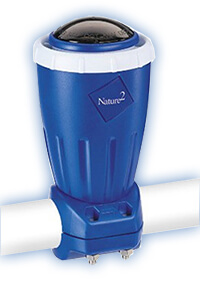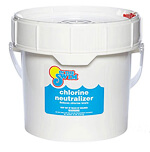FREE Standard Shipping On All Orders $100 or More!*
Pool Chlorine Levels
Welcome back students! Today in Pool Chemistry 101, we cover some common chlorine concerns for pool owners.
The topic is the best chlorine levels for swimming pools; let's start with the general, and move towards the specific.
Every pool is different - and not just in shape and size, but in chlorine demand, or how much chlorine is needed to do the job.
Proper Pool Chlorine Level?
The minimum acceptable level for most swimming pools is 1.0 ppm (parts per million), up to 3.0 ppm.
What Affects Chlorine Level?: Heavy bather load, heavy debris or algae requires higher chlorine levels to compensate for the increased workload. In addition, long hours of sunlight, a high pool pH, poor filtration or circulation, can also require more chlorine, to keep and maintain a constant and consistent 1-3 ppm of chlorine.
How is Chlorine Tested?: Test for proper chlorine levels with a fresh test strip or liquid reagent test kit. Strips that are outdated, or reagents that are contaminated, have frozen or been exposed to direct sunlight can produce inaccurate results.
How are Chlorine Levels Raised?: Pool operators can raise chlorine levels using any pool chlorine product - dichlor granular, trichlor tablets, cal hypo granular or lithium powder - even liquid bleach, but most folks use Trichlor for daily chlorination, and Cal Hypo as a periodic shock treatment.
Chlorine Level for Saltwater Pools?
The proper level of chlorine for a saltwater pool is exactly the same as for a pool chlorinated with tablets; 1-3 ppm. Salt pools don't require less chlorine than traditional pools, despite what you may have heard.
Chlorine Level for Pools with Supplemental Sanitizers?

A pool with a supplemental sanitizer has additional equipment that reduces the chlorine demand. These include mineral purifiers, such as Nature2 or Frog, or an Ozonator.
Public pools are still required to meet the minimum health department standard of 1.0 ppm, but for residential pools with a supplemental sanitizer doing half the work, the minimum acceptable chlorine level drops to 0.5 ppm.
However, there are times when a higher amount of chlorine would be prudent in a pool with supplemental sanitizers, in addition to regular super-chlorination or shock treatments.
Chlorine Level for Stabilized Pools?
Stabilized pools have cyanuric acid, also known as conditioner, to protect the chlorine molecule from UV light degradation. It does this not by shielding chlorine from sun like an overcoat or umbrella, but by reducing it's activity, or specifically, it's vibrations.
For this reason, some health departments are now calling for higher minimum levels of Free Chlorine, in pools stabilized with cyanuric acid.
For stabilized pools, the best chlorine level is in the 2-3 ppm range.
Chlorine Level Too High?

Above 5 ppm, you may begin to notice irritation to the skin and eyes, and above 10 ppm, people should not be allowed in the pool.
Besides skin and hair damage, consistently high chlorine levels can bleach swim suits and weaken vinyl liners, pump seals, filter cartridges and pool heaters.
Testing very high (off the chart) chlorine levels can be accomplished by using a 50/50 solution of pool water and distilled water, and then doubling the tested chlorine level.

Chlorine Neutralizer is available, namely sodium thiosulfate, which will quickly bring over-chlorinated pools back to normal chlorine levels. Use with care, overdose can lead to an opposite problem of difficulty obtaining a chlorine reading!
Chloramine Level?
Chloramines are also called combined chlorine, created when ammonia or nitrogen latches onto a Free Chlorine molecule, rendering it useless.
An acceptable level of chloramines in a pool is 0.3 ppm or less. At this point you may begin to smell them, or experience eye irritation.

When chloramine levels reach 0.3 ppm, the pool should be shocked or superchlorinated to 10 ppm, to break apart the chloramine bonds.
Chloramines can be tested by using a DPD test kit, or test strips that test for both Total Chlorine and Free Chlorine. If there is any difference between the two tests, chloramines are present. The formula is thus: TC - FC = CC
And, that's about all folks!